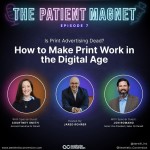Optimizing Your Dental Practice Website for Lead Generation
In this digital age, a well-optimized website is crucial for any dental practice to attract new patients and grow its business. In this article, Darwill walks you through essential steps to optimize your dental practice website for lead generation.
With over 15 years working on marketing strategies for dental practice groups and DSOs, we understand how to make your website an effective tool for generating leads and getting more attended appointments.
Understanding Your Audience
The first step in optimizing your dental practice website is understanding your audience. Targeting the right audience can significantly increase your chances of generating quality leads.
Identifying Your Ideal Patient
Begin by creating a detailed profile of your ideal patient. Consider factors such as age, gender, location, and dental needs. For example, if you're a pediatric dentist, your target audience would be parents of young children. Understanding these demographics helps tailor your website's content and design to appeal to your ideal patient.
Conducting Audience Research
To gather information about your current patients and website visitors, use surveys, social media polls, and feedback forms. This data can reveal valuable insights into their preferences, pain points, and what they're looking for in a dental practice. Armed with this knowledge, you can create service pages, blogs, and other website content that addresses their specific dental needs and concerns.
Website Optimization Basics
Improving user experience and search engine visibility are fundamental aspects of website optimization. A well-optimized website not only attracts more visitors but also converts them into leads.
Ensuring Mobile-Friendliness
With more people using smartphones for web browsing, having a mobile-friendly website is non-negotiable. Ensure your website is responsive, meaning it adjusts seamlessly to different screen sizes. Mobile friendliness improves user experience and boosts your search engine rankings.
Speed Matters
Website loading speed is a critical factor in user experience. A slow-loading site can frustrate visitors and lead to low engagement rates. Use tools like Google PageSpeed Insights to identify and fix issues that may be slowing down your site. Optimizing images and videos, leveraging browser caching, and minimizing code are some ways to speed up your website.
Clear Navigation
A well-structured website with clear navigation helps visitors find information quickly. Use an easy-to-navigate menu structure with links to important pages such as services, contact details, and appointment scheduling. A search bar can also enhance user experience by allowing visitors to find specific content effortlessly.
In addition to clear navigation, it's crucial that your appointment scheduler or contact form is user-friendly. The appointment scheduler or contact form should be easily accessible from the navigation menu and straightforward to fill out. Lengthy forms or complex schedulers may deter users from completing them.
It’s important to ensure the information the web visitor seeks can be found in a few clicks. If the information they require is buried in the website, you risk the web user leaving and going to a competitor’s website.
Content Strategy
Content is king when it comes to engaging and converting website visitors. Crafting compelling and informative content on hot dental topics and service offerings can significantly boost your lead generation efforts.
Creating Valuable Content
Your website should offer valuable content that addresses your audience's needs and concerns. Blog posts can educate potential patients and encourage them to book an appointment. FAQs and detailed service pages can provide useful information and establish your authority in the dental field.
Using Visual Content
Visual content, such as videos and infographics, can make your website more engaging and appealing. Consider creating video tutorials on proper dental hygiene or showcasing patient testimonials. 79% of consumers prefer watching a video on a service, this is great to keep them engaged and on the page. Visual content can convey complex information in an easily digestible format and keep visitors on your site longer.
Updating Content Regularly
Updating your website with fresh content signals to search engines that your site is active and relevant. It also keeps your audience engaged and coming back for more. Set a content calendar to plan and schedule blog posts, articles, and updates on your service pages.
Local SEO for Dental Practices
Local SEO is essential for attracting nearby patients. By leveraging local search strategies, you can ensure your dental practice appears in local search results and maps.
Claiming Your Google Business Profile
One of the first steps in local search engine optimization (SEO) is claiming and optimizing your Google Business Profile (GBP). This free tool allows you to manage how your business appears in Google search results and maps. This is essential because it is often the first place the search users look when obtaining contact information about your practice. It also boosts your credibility of being a legitimate local business.
Ensure your Business Profile is complete with accurate information. This includes your address, phone number, business hours, and services offered. Consumers are 70% more likely to visit a website and 50% more likely to consider booking an appointment from practices with a complete Business Profile.
Encouraging Patient Reviews
Online reviews play a significant role in local SEO and building trust with potential patients. Encourage satisfied patients to leave positive reviews on Google, Yelp, and other review platforms. Responding to positive and negative reviews shows that you value patient feedback and are committed to providing excellent service.
Local Keywords and Content
Incorporate local keywords into your website content to improve your chances of appearing in local search results. For example, use “near me” searches like “dentist near me” and phrases like "best dentist in [your city]." Additionally, create location-specific content, such as blog posts about dental health tips for residents in your area.
Conversion Rate Optimization (CRO)
Conversion Rate Optimization (CRO) involves tactics to turn website visitors into leads. Enhancing your website's ability to convert visitors is crucial for lead generation.
Clear Calls to Action (CTAs)
Every page on your website should have a clear and compelling call to action (CTA). Whether it's booking an appointment, signing up for a newsletter, or downloading a free dental health guide, make sure your CTAs stand out and are easy to follow. Use actionable language, such as "Schedule Your Appointment Today" or "Get Your Free Consultation."
Simplify Appointment Booking
Make the appointment booking process as straightforward as possible. An easy-to-use online booking system can significantly increase conversion rates. Ensure the booking form is simple, with minimal fields to fill out. Offering multiple contact options, such as phone, email, and live chat, can also cater to different preferences.
Use Trust Signals
Trust signals, such as patient testimonials, certifications, and awards, can build credibility and reassure potential patients. Display these prominently on your website, especially on landing pages and service pages. Trust signals can alleviate concerns and convince visitors to choose your dental practice.
Measuring Success
Tracking website performance and the effectiveness of your lead generation efforts is essential for continuous improvement. Use various tools and metrics to measure success and identify areas for optimization.
Google Analytics
Google Analytics is a powerful tool for tracking website traffic, user behavior, and conversions. Set up events to track specific actions, such as appointment bookings or contact form submissions. Analyzing this data helps you understand how visitors interact with your site and which pages drive the most conversions.
Conversion Tracking
Implement conversion tracking to measure the success of your lead generation efforts accurately. Tools like Google Tag Manager can help you track conversions from various sources, including organic search, paid ads, and social media. Conversion tracking provides valuable insights into the effectiveness of your marketing campaigns.
Regular Reporting
Create regular reports to monitor your website's performance and lead generation metrics. These reports should include key performance indicators (KPIs) such as traffic, engagement rates, conversion rates, and average engagement time per session. Regular reporting allows you to identify trends, measure progress, and make data-driven decisions.
Gain More Attended Appointments with an Optimized Website
Optimizing your dental practice website for lead generation is a multifaceted process that requires a comprehensive and ongoing approach. By understanding your audience, improving user experience, crafting valuable content, leveraging local SEO, and optimizing for conversions, you can transform your website into a powerful tool for attracting new patients.
If you need expert assistance, consider partnering with a professional marketing agency like Darwill to enhance your lead generation strategies.
Ready to take your dental practice website to the next level? Start implementing these strategies today and watch your practice grow!



